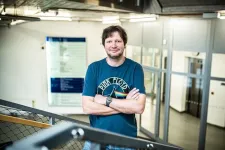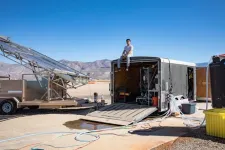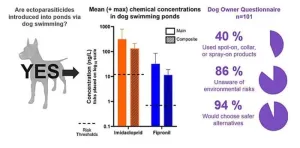(Press-News.org) Two new apps will enable blind people to navigate indoor buildings with spoken directions from a smartphone app, providing a safe method of wayfinding where GPS doesn’t work.
UC Santa Cruz professor of Computer Science and Engineering Roberto Manduchi has devoted much of his research career to creating accessible technology for the blind and visually impaired. Throughout years of working with these communities, he has learned that there is a particular need for tools to help with indoor navigation of new spaces.
“Moving about independently in a place that you don't know is particularly difficult, because you don't have any visual reference — it’s very easy to get lost. The idea here is to try to make this a little bit easier and safer for people,” Manduchi said.
In a new paper published in the journal ACM Transactions on Accessible Computing, Manduchi’s research group presents two smartphone apps that provide indoor wayfinding, navigation to a specific point, and safe return, the process of tracing back a past route. The apps give audio cues and don’t require a user to hold their smartphone in front of themselves, which would be inconvenient and attract undue attention.
Safer, scalable technology
Smartphones provide a great platform for hosting accessible technology because they are cheaper than a dedicated hardware system, have the support of the company's information technology teams, and are equipped with built-in sensors and accessibility features.
Other smartphone-based wayfinding systems require a person to walk with their phone out, which can create several problems. A blind person navigating a new space often has at least one hand in use for a guide dog or a cane, so using the other for a phone is less than ideal. Holding a phone out also leaves the navigator vulnerable to crime, and people with disabilities already experience criminality at disproportionately higher rates.
While companies like Apple and Google have developed indoor wayfinding for some specific locations, such as major airports and stadiums, their methods depend on sensors that are installed inside these buildings. This makes it a much less scalable solution due to the cost of adding and maintaining extra infrastructure.
Using built-in sensors
Manduchi’s wayfinding app provides a route in a similar way to GPS services like Google Maps; however, GPS-based systems don’t work indoors because the satellite signal is distorted by a building’s walls. Instead, Manduchi’s system uses other sensors within a smartphone to provide spoken instructions to navigate an unfamiliar building.
The wayfinding app works by using a map of the inside of a building to find a path toward the destination, and then uses a phone’s built-in inertial sensors, accelerometers and gyros, which provide for features like a step counter, to track the navigator's progress along the path.
The same sensors can also track the orientation of the phone and therefore the navigator. However, the estimated location and orientation are often somewhat inaccurate, so the researchers incorporated another method called particle filtering to enforce the physical constraints of a building so it does not interpret that the navigator is walking through walls or other impossible situations.
The backtracking app simply inverts a route previously taken by a navigator, helpful for situations in which a blind person is guided into a room and wants to leave independently. In addition to inertial sensors, it uses the phone’s magnetometer to identify characteristic magnetic field anomalies, typically created by large appliances, which can serve as landmarks within a building.
Communicating directions
Both systems give directions through spoken communication and can also be used with a smartwatch to supplement the instructions with vibrations. Overall, the researchers tried to minimize the amount of input given to the navigator so that they could focus on safety.
They also rely on the navigator to make judgements about where to turn, to account for any error in tracking. The system instructs a person to make their next directional change five meters before it anticipates the turn will occur, with directions like “at the upcoming junction, turn left,” and the navigator can begin to find the turn with the help of their cane or guide dog.
“Sharing responsibility, in my opinion, is the right approach,” Manduchi said. “As a philosophy, you cannot rely on technology alone. That is also true when you drive a car — if it says turn right, you don’t just immediately turn right, you look for where the junction is. You need to work with the system.”
Testing their systems in the Baskin Engineering building at UC Santa Cruz, the research team found that users were able to successfully navigate the many hallways and turns. The team will continue to polish their apps, which use the same interface but are separate for the ease of development.
Going forward, they will focus on integrating AI features that could allow a navigator to take a photo of their surroundings and get a scene description if they are in a particularly hard area to navigate, like an alcove of a building or a wide-open space. They also want to enhance the ability to access and download building maps, perhaps taking advantage of an open source software ecosystem to do so.
“I’m very grateful to the blind community in Santa Cruz, who gave me fantastic advice. [As engineers creating technology for the blind community], you have to be very, very careful and very humble, and start from the person who will use the technology, rather than from the technology itself,” Manduchi said.
END
New apps will enable safer indoor navigation for blind people
2024-10-08
ELSE PRESS RELEASES FROM THIS DATE:
Scientists from IOCB Prague help to improve medical drugs
2024-10-08
Researchers from IOCB Prague are furthering the understanding of how medicines work and what it takes to develop their most effective variants. In one current study, they have focused on the disease caused by the protozoan parasite Trichomonas vaginalis, especially because of the recent appearance of strains that are resistant to conventional treatment. In an effort to find a new weak spot of this parasite, the research group led by Dr. Evžen Bouřa has succeeded in preparing a key enzyme complex – the proteasome. This has made it possible to gain knowledge that is indispensable for the development of new effective ...
Recreating a hallmark of Parkinson's disease in human neurons
2024-10-08
Lewy bodies are a hallmark of Parkinson's disease (PD) and other related neurological conditions. Understanding why and how they develop is critical to developing better treatments. A study from The Neuro (Montreal Neurological Institute-Hospital) of McGill University, in collaboration with its Early Drug Discovery Unit, has recreated the growth of Lewy bodies in human neurons and followed their formation to gain important insight into why and how they form. Critically, they find that immune challenge is important for this process, identifying a previously unknown link between the immune system and neurological disease.
Lewy ...
Solar-powered desalination system requires no extra batteries
2024-10-08
MIT engineers have built a new desalination system that runs with the rhythms of the sun.
The solar-powered system removes salt from water at a pace that closely follows changes in solar energy. As sunlight increases through the day, the system ramps up its desalting process and automatically adjusts to any sudden variation in sunlight, for example by dialing down in response to a passing cloud or revving up as the skies clear.
Because the system can quickly react to subtle changes in sunlight, it maximizes the utility of solar energy, producing large quantities of clean water despite ...
When it comes to emergency care, ChatGPT overprescribes
2024-10-08
Generative AI still needs to find the right balance between too little and too much care before it can help doctors make decisions in the Emergency Department.
If ChatGPT were cut loose in the Emergency Department, it might suggest unneeded x-rays and antibiotics for some patients and admit others who didn’t require hospital treatment, a new study from UC San Francisco has found.
The researchers said that, while the model could be prompted in ways that make its responses more accurate, it’s still no match for the clinical judgment of a human doctor.
“This ...
Speakers to tackle global health challenges at WISH 2024
2024-10-08
7 October 2024. Doha, Qatar – The World Innovation Summit for Health (WISH) has today released the first details of speakers confirmed for its upcoming global conference, to be held on 13 and 14 November 2024.
Among those featured at the summit will be WISH executive chair Lord Ara Darzi of Denham and Médecins Sans Frontières’ international president Christos Christou.
Lord Darzi, who recently led an independent investigation on the state of the National Health Service in England, will ...
Mental health app could help prevent depression in young people at high risk
2024-10-08
A cognitive behavioural therapy (CBT) app has been found to significantly prevent increases in depression in young people who are at high risk - and could be implemented as a cost effective public mental health measure.
Globally, concern is growing about the high and steadily increasing rates of anxiety and depression in young people. Effective and scalable ways of preventing poor mental health in this group are needed, and digital tools such as mobile apps have been proposed as part of the solution.
Whilst there is emerging evidence ...
Dogs contaminate London ponds with parasite medications
2024-10-08
Most dog owners didn’t know that flea and tick treatments are dangerous to aquatic life, suggesting more awareness could ease the problem.
A study on Hampstead Heath shows that ponds where dogs are allowed to swim contain levels of two pesticides harmful to invertebrate life.
These pesticides, imidacloprid and fipronil, are used as parasite treatments for flea and tick infestations in cats and dogs, using ‘spot-on’ formulas and flea collars. This is despite these chemicals being banned for agricultural use in 2018 due to their toxicity to bees and other ...
Oh my meniscus: age poses risk of further knee injury in children
2024-10-08
Growing pains are common in maturing children, but sometimes this growth can be irregular and cause injury. Discoid lateral meniscus (DLM), a misshapen knee cartilage, is one such occurrence that can degenerate into osteochondritis dissecans, a joint disorder where the bone and joint begin to separate from the rest of the bones. It has been reported that osteochondritis dissecans of the femoral condyle occurs in approximately 14.5% of cases of DLM, but there has been little analysis of its treatment to date.
Dr. Ken Iida and Specially ...
Increase access to nature in all daily environments and in education
2024-10-08
Although access to nature is a basic human right, people’s actual use of green spaces is subject to inequalities. A Kobe University-led research team analyzed what conditions make it more likely that people are exposed to nature across generations: the availability of green spaces around where they live, work and shop, as well as nature relatedness and past natural experiences. Their findings may inform policies for urban planning and education for the improvement of human health.
Visiting green spaces is good for people’s health, both psychologically and physiologically. ...
AI speeds up the discovery of energy and quantum materials.
2024-10-08
Researchers from Tohoku University and the Massachusetts Institute of Technology (MIT) have unveiled a new AI tool for high-quality optical spectra with the same accuracy as quantum simulations, but working a million times faster, potentially accelerating the development of photovoltaic and quantum materials.
Understanding the optical properties of materials is essential for developing optoelectronic devices, such as LEDs, solar cells, photodetectors, and photonic integrated circuits. These devices are pivotal in the semiconductor industry's current resurgence.
Traditional means of calculation using the basic laws of physics involve complex ...








